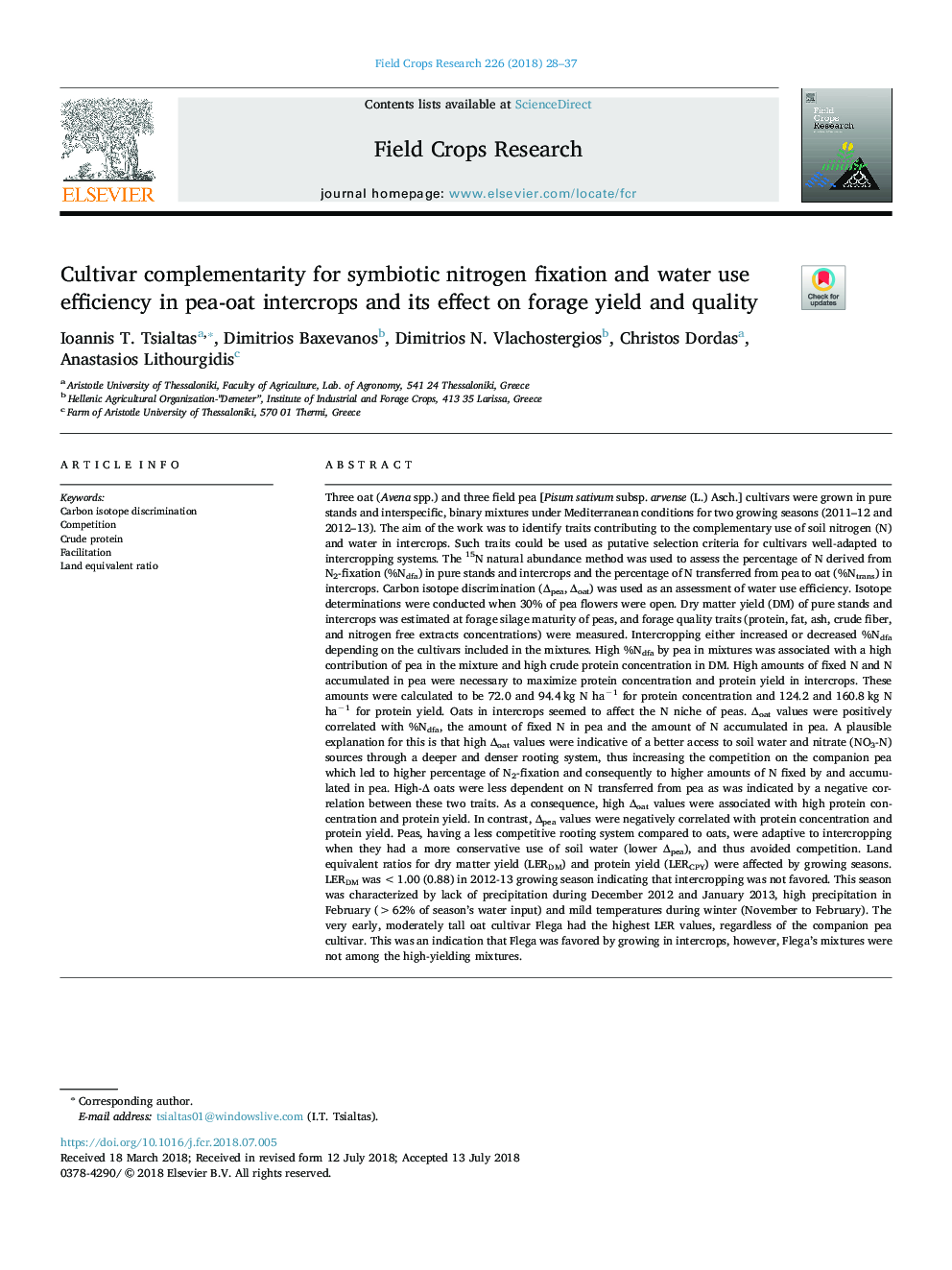| کد مقاله | کد نشریه | سال انتشار | مقاله انگلیسی | نسخه تمام متن |
|---|---|---|---|---|
| 8879067 | 1624637 | 2018 | 10 صفحه PDF | دانلود رایگان |
عنوان انگلیسی مقاله ISI
Cultivar complementarity for symbiotic nitrogen fixation and water use efficiency in pea-oat intercrops and its effect on forage yield and quality
ترجمه فارسی عنوان
مکمل بودن ارقام برای تثبیت نیتروژن همزیستی و بازده مصرف آب در اینترکوپ نخود فرنگی و تأثیر آن بر عملکرد و کیفیت
دانلود مقاله + سفارش ترجمه
دانلود مقاله ISI انگلیسی
رایگان برای ایرانیان
کلمات کلیدی
تبعیض ایزوتوپ کربن، رقابت، پروتئین خام تسهیلات، نسبت معادل زمین،
موضوعات مرتبط
علوم زیستی و بیوفناوری
علوم کشاورزی و بیولوژیک
علوم زراعت و اصلاح نباتات
چکیده انگلیسی
Three oat (Avena spp.) and three field pea [Pisum sativum subsp. arvense (L.) Asch.] cultivars were grown in pure stands and interspecific, binary mixtures under Mediterranean conditions for two growing seasons (2011-12 and 2012-13). The aim of the work was to identify traits contributing to the complementary use of soil nitrogen (N) and water in intercrops. Such traits could be used as putative selection criteria for cultivars well-adapted to intercropping systems. The 15N natural abundance method was used to assess the percentage of N derived from N2-fixation (%Ndfa) in pure stands and intercrops and the percentage of N transferred from pea to oat (%Ntrans) in intercrops. Carbon isotope discrimination (Îpea, Îoat) was used as an assessment of water use efficiency. Isotope determinations were conducted when 30% of pea flowers were open. Dry matter yield (DM) of pure stands and intercrops was estimated at forage silage maturity of peas, and forage quality traits (protein, fat, ash, crude fiber, and nitrogen free extracts concentrations) were measured. Intercropping either increased or decreased %Ndfa depending on the cultivars included in the mixtures. High %Ndfa by pea in mixtures was associated with a high contribution of pea in the mixture and high crude protein concentration in DM. High amounts of fixed N and N accumulated in pea were necessary to maximize protein concentration and protein yield in intercrops. These amounts were calculated to be 72.0 and 94.4âkg N haâ1 for protein concentration and 124.2 and 160.8âkg N haâ1 for protein yield. Oats in intercrops seemed to affect the N niche of peas. Îoat values were positively correlated with %Ndfa, the amount of fixed N in pea and the amount of N accumulated in pea. A plausible explanation for this is that high Îoat values were indicative of a better access to soil water and nitrate (NO3-N) sources through a deeper and denser rooting system, thus increasing the competition on the companion pea which led to higher percentage of N2-fixation and consequently to higher amounts of N fixed by and accumulated in pea. High-Î oats were less dependent on N transferred from pea as was indicated by a negative correlation between these two traits. As a consequence, high Îoat values were associated with high protein concentration and protein yield. In contrast, Îpea values were negatively correlated with protein concentration and protein yield. Peas, having a less competitive rooting system compared to oats, were adaptive to intercropping when they had a more conservative use of soil water (lower Îpea), and thus avoided competition. Land equivalent ratios for dry matter yield (LERDM) and protein yield (LERCPY) were affected by growing seasons. LERDM was <1.00 (0.88) in 2012-13 growing season indicating that intercropping was not favored. This season was characterized by lack of precipitation during December 2012 and January 2013, high precipitation in February (>62% of season's water input) and mild temperatures during winter (November to February). The very early, moderately tall oat cultivar Flega had the highest LER values, regardless of the companion pea cultivar. This was an indication that Flega was favored by growing in intercrops, however, Flega's mixtures were not among the high-yielding mixtures.
ناشر
Database: Elsevier - ScienceDirect (ساینس دایرکت)
Journal: Field Crops Research - Volume 226, 1 September 2018, Pages 28-37
Journal: Field Crops Research - Volume 226, 1 September 2018, Pages 28-37
نویسندگان
Ioannis T. Tsialtas, Dimitrios Baxevanos, Dimitrios N. Vlachostergios, Christos Dordas, Anastasios Lithourgidis,
